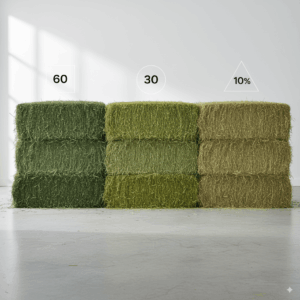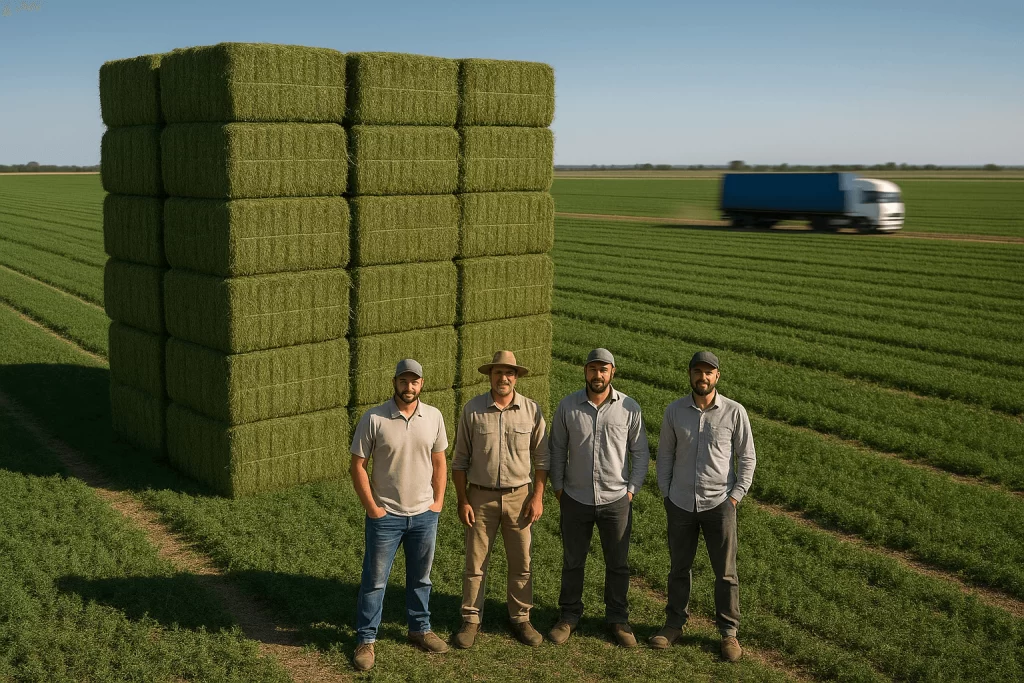Exporting alfalfa from Argentina represents a major opportunity for local producers aiming to enter international markets. But there’s one key question many ask before taking that step: Does alfalfa lose quality during transportation for export? The short answer is yes—if the proper measures are not taken.
Why is alfalfa so sensitive during transportation?
Perishable nature of the forage
Alfalfa bales for export are still a living forage. Even when compacted and dried, they continue to react to environmental conditions. Unlike other agricultural products, their nutritional properties, moisture content, and structure can be altered during the journey.
Factors that speed up deterioration
The most common issues include moisture during alfalfa transport, lack of ventilation, long transit times, and especially poor packaging. These conditions can cause loss of quality in exported alfalfa, which often results in lower market prices or customs rejections.
Main risks alfalfa faces in transit
Temperature and humidity fluctuations
Maritime transport of alfalfa often exposes the product to extreme weather and sudden temperature changes. If internal moisture is not controlled, mold and fungi can easily appear, reducing the forage’s value.
Pest or mold contamination
One of the most common problems in alfalfa transportation for export is the lack of pest control. Even minor contamination can lead to total loss if not detected early.
Logistics delays and their impact
Delays in alfalfa export logistics increase exposure to non-ideal conditions. Many companies underestimate this, only to end up with decreased protein content or partial fermentation.
What conditions must be controlled to prevent losses?
Moisture control and ventilation
Safe transport requires strict moisture control in alfalfa for export. Ideally, moisture levels should not exceed 12%, and passive or active ventilation should be used depending on climate and container type.
Proper packaging to protect the forage
Packaging for safe international alfalfa export must prevent contact with water, direct sunlight, or CO₂-heavy environments. Special films or insulated containers can make a big difference here.
Continuous monitoring during transport
Many companies now use temperature and humidity sensors to help preserve the quality of exported alfalfa. These tools alert stakeholders if critical thresholds are exceeded during transit, allowing early intervention.
What kind of transport best preserves alfalfa quality?
Land vs. sea transportation comparison
Transport type depends on the destination. For nearby countries, land transport of alfalfa for export is usually quicker and less risky. For long-distance markets like Asia or the Middle East, maritime transport is necessary and must be carefully planned.
Advantages of specialized containers
Using ventilated or refrigerated containers can be a game changer. These maintain stable temperature and humidity, which is essential to avoid quality loss in long-distance alfalfa shipments.
Trip duration considerations
In general, the shorter the time between harvest and delivery, the higher the product quality. This is why many producers develop efficient alfalfa export logistics to minimize stops, layovers, and transfers.
How is alfalfa quality controlled during shipment?
Traceability and monitoring systems
Sensors, QR codes, and real-time reports are now standard practice. This helps track the quality of exported alfalfa step by step and react quickly when issues arise.
Inspection protocols at critical points
Key checkpoints usually include the farm, repacking center, port, and destination. At each point, it’s recommended to check for moisture levels, pest presence, and bale compactness to reduce risks and maintain standards.
Emerging cargo tracking technologies
Beyond GPS, some companies are already using artificial intelligence to predict quality risks based on weather or route. This helps prevent common mistakes when transporting alfalfa for export.
What regulations must be followed to export alfalfa without compromising its quality?
International phytosanitary requirements
Exporting to countries like China, Saudi Arabia, and the UAE requires compliance with strict rules. These may include microbiological testing, maximum moisture thresholds, and full traceability. Failing to meet them could result in rejection or penalties.
Required documentation and certifications
SENASA certification to export alfalfa from Argentina is essential. Additional requirements may include Halal certification, heavy metal analysis, and origin declarations.
Importer-specific standards
Each country has unique import standards. For instance, exporting alfalfa to the UAE requires a minimum protein level, while exporting to China demands pre-shipment fumigation and GMO-free guarantees.
Practical tips for maintaining alfalfa quality during export
Efficient logistics planning
It all starts with a plan that includes harvest time, drying, compressing, transportation, customs clearance, and delivery. Reducing the number of intermediaries gives producers more control over the entire process.
Staff training on handling and transport
From the field worker loading the truck to the customs officer, everyone must understand the importance of keeping the forage dry, clean, and properly compacted.
Real-time monitoring technologies
Apps and online platforms give full visibility of each shipment. If a problem is detected mid-journey, corrective actions can be taken before the situation worsens.
Conclusion
Transporting alfalfa efficiently and without losing quality is entirely possible—if you pay attention to the details. From moisture control to the choice of containers, every decision adds up.
With well-planned logistics, trained staff, and smart technology, you can export alfalfa without losing quality and compete in even the most demanding markets.
Want help planning a successful export journey? We’re here to help you design your plan—from field to port. Because when it comes to quality, there’s no room for compromise.





